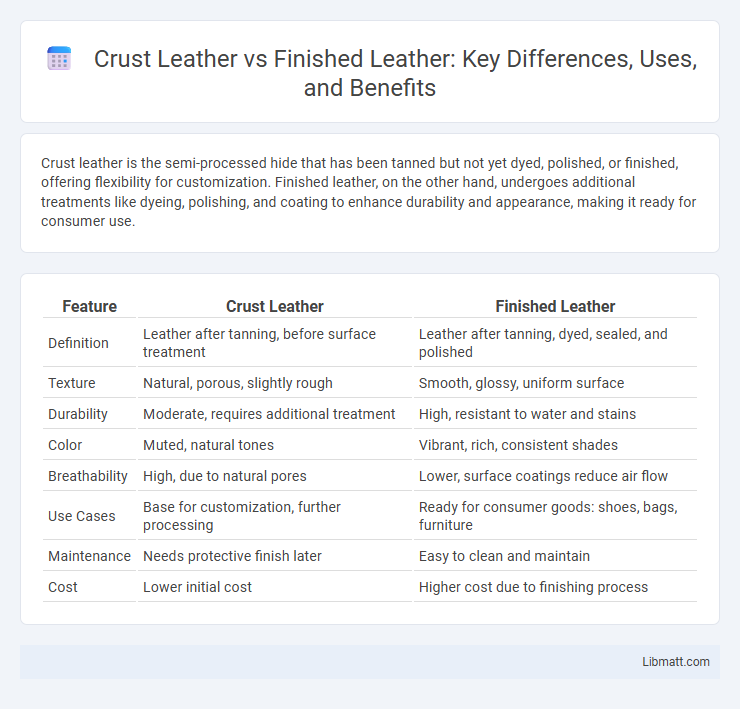Crust leather is the semi-processed hide that has been tanned but not yet dyed, polished, or finished, offering flexibility for customization. Finished leather, on the other hand, undergoes additional treatments like dyeing, polishing, and coating to enhance durability and appearance, making it ready for consumer use.
Table of Comparison
| Feature | Crust Leather | Finished Leather |
|---|---|---|
| Definition | Leather after tanning, before surface treatment | Leather after tanning, dyed, sealed, and polished |
| Texture | Natural, porous, slightly rough | Smooth, glossy, uniform surface |
| Durability | Moderate, requires additional treatment | High, resistant to water and stains |
| Color | Muted, natural tones | Vibrant, rich, consistent shades |
| Breathability | High, due to natural pores | Lower, surface coatings reduce air flow |
| Use Cases | Base for customization, further processing | Ready for consumer goods: shoes, bags, furniture |
| Maintenance | Needs protective finish later | Easy to clean and maintain |
| Cost | Lower initial cost | Higher cost due to finishing process |
Understanding Crust Leather: Definition and Characteristics
Crust leather refers to tanned leather that has not yet undergone surface finishing, retaining a natural, porous texture suitable for further dyeing or coating. This type of leather maintains its breathability and softness, allowing manufacturers to customize surface treatments such as polishing, embossing, or coloring based on specific product requirements. Understanding crust leather is crucial for industries seeking high-quality, adaptable leather materials before applying the final finish that defines aesthetic and protective properties.
What is Finished Leather? Key Features Explained
Finished leather is a type of leather that has undergone a surface treatment process to enhance its appearance and durability. It features a protective coating, often pigmented or lacquered, which provides a smooth, consistent texture and color while offering resistance to water, stains, and abrasion. This type of leather is commonly used in upholstery, fashion, and accessories due to its polished look and ease of maintenance.
The Manufacturing Process: Crust vs Finished Leather
Crust leather undergoes initial tanning, drying, and sometimes coloring without surface coatings, allowing for greater flexibility in later finishing applications. Finished leather receives additional treatments such as dyeing, buffing, embossing, and protective surface coatings, resulting in a polished, uniform appearance. Understanding these manufacturing processes helps you choose leather tailored to specific durability and aesthetic requirements.
Texture and Appearance: How Crust and Finished Leather Differ
Crust leather features a natural, raw texture with visible grain and a matte finish, offering a more organic and authentic appearance. Finished leather undergoes surface treatments such as polishing, dyeing, and coatings, resulting in a smooth, uniform texture with enhanced color vibrancy and shine. Your choice between crust and finished leather impacts the tactile feel and visual appeal, depending on whether you prefer a rustic, natural look or a refined, glossy surface.
Durability Comparison: Crust Leather vs Finished Leather
Crust leather offers superior durability due to its natural, semi-processed state that retains the hide's original strength and breathability, making it less prone to cracking and wear over time. Finished leather undergoes additional surface treatments and coatings that enhance water resistance and aesthetic appeal but may reduce flexibility and increase susceptibility to surface damage under heavy use. Consumers seeking long-lasting leather products often prefer crust leather for its balance of durability and natural aging characteristics compared to the augmented finishes of finished leather.
Color and Dyeing Techniques: Analyzing Both Types
Crust leather retains its natural color and lacks surface finishes, making it ideal for custom dyeing and coloring techniques that allow for deep penetration of dyes and a unique, authentic appearance. Finished leather undergoes additional surface treatments like coatings and pigments that provide uniform color and protection but limit the ability to alter or deepen the color through subsequent dyeing. Understanding these differences helps you choose between crust leather's versatility in customization and finished leather's ready-made consistency in color and finish.
Maintenance and Care: Best Practices for Each
Crust leather requires gentle maintenance using minimal water and specialized leather conditioners to preserve its natural, unfinished surface and prevent drying or cracking. Finished leather benefits from more frequent cleaning with mild soaps and conditioning to maintain its protective coatings, which resist stains and moisture more effectively. You should tailor your care routine to the leather type to enhance durability and keep its appearance pristine over time.
Common Uses: Applications of Crust and Finished Leather
Crust leather is commonly used in fashion accessories, upholstery, and footwear where further customization and finishing are required, offering versatility for dyeing and coating processes. Finished leather, with its protective surface and enhanced durability, is preferred in high-end furniture, automotive interiors, and luxury goods that demand consistent appearance and resistance to wear. Understanding the specific requirements of each application helps determine the choice between untreated crust leather and fully finished leather products.
Environmental Impact: Sustainability of Crust and Finished Leather
Crust leather is more environmentally sustainable than finished leather because it undergoes less chemical processing and fewer toxic treatments, reducing pollution and energy consumption. Finished leather involves extensive dyeing, plating, and coating steps that increase chemical waste and water usage, amplifying its environmental footprint. Choosing crust leather supports eco-friendly practices by minimizing harmful emissions and conserving natural resources in your leather products.
Choosing the Right Leather: Factors to Consider
Crust leather offers a natural, untreated surface that allows for personalized finishing, making it ideal for custom projects requiring unique textures and colors. Finished leather, treated with dyes and protective coatings, provides durability and consistent appearance suitable for high-traffic applications like furniture and footwear. When choosing the right leather, consider your desired look, maintenance level, and the specific use to ensure your project's longevity and aesthetic appeal.
Crust leather vs finished leather Infographic

 libmatt.com
libmatt.com